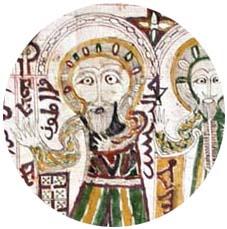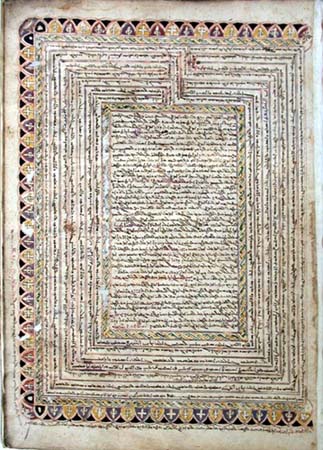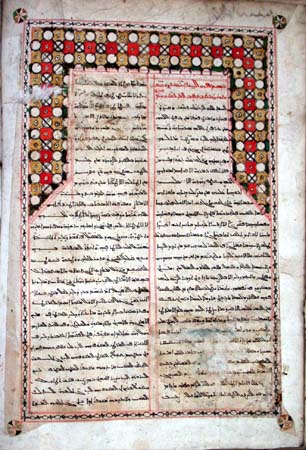| Please note that these pages are from our old (pre-2010) website; the presentation of these pages may now appear outdated and may not always comply with current accessibility guidelines. |
| Please note that these pages are from our old (pre-2010) website; the presentation of these pages may now appear outdated and may not always comply with current accessibility guidelines. |

| This Arabic manuscript, written on stout oriental paper, probably dates from fifteenth century Mesopotamia. It is written mostly in Syriac script - Serta for the main text, and Estrangela for inscriptions on the illumination. Arabic script is also employed for the headings to the tables. Such manuscripts are called Karshūnī and the practice is exclusive to Arabic written by Syrian Christians. |
|
|
Abū Alī Yahyā Ibn 'Isā Ibn Jazla, known
also in the West as Ben Gesla or Byngazlawas, was born a Christian, but
converted to Islam in 1074 under the influence of his teacher Mu'tazilī
Abū 'Alī Ibn al-Walīd. He practised as a physician in his place of
birth, Baghdad, in the al-Karkh quarter, and is reputed to have treated
his neighbours and friends without payment. He died in 1100. Three works by Ibn Jazla have come down to us, al-Radd 'ala al-Nasārā, a treatise on his conversion to Islam, condemning both Christianity and Judaism, Minhāj al-bayān fī mā yasta'milu al-insān, an alphabetical list of plants and drugs, and the Taqwīm. Ibn Jazla dedicated this work 'the arrangement of bodies for treatment' to the Abbasid Caliph al-Muqtadi bi-Amr Allah. In it, illnesses, dietary matters and hygiene are treated in tabular form (hence Taqwim, Latinised as Tacuinum). In all there are 44 tables, describing 352 maladies. In each case the name of the illness, its cause and symptoms are recorded on one page, and an appropriate curative regime (tadbīr) is indicated on the page facing. |
|
|
|
At table 16, 'Illnesses of the brain and its sections', John Channing - who owned the manuscript in the eighteenth century - has inserted a note mentioning inter alia, Lycanthropia = qatrab, and Amor = 'ishk, the former introduced into Arabic medicine from the works of Marcellus of Side and Aetius of Amida, who classed this phenomenon as a psychopathology. The last of the great Arabic translators of the Sicilian School was Farragius Judaeus who died in 1285 and who translated into Latin not only this work as Tacuim Aegritudinem (published Strasbourg 1532) but also the Continens of Rhazes.
|
|
|
|
| As contemporary Islamic medicine was heavily dependent on the legacy of the Greeks, transmitted through Middle-Persian, and especially Syriac writings and translations, it is not surprising that we find the major authorities (right to left), Aristotle, Galen and Plato depicted on the illuminated frontispiece to this codex. The fourth figure is labelled 'this is Hayqār Hakīm .' who may be identified with Ahiqar (Hayqār in Arabic) the legendary wise man and counsellor of Sennacherib, the king of Assyria. At the head of this page, in Arabic (in Arabic script) is the statement: 'These are the wise who know God: He is the wise the healer'. On the opposite page, in both Syriac and Arabic, at the top: Origanis; at the foot: Hermes Augustus. Apart from the figures depicted on the opening leaves, the illumination in the rest of the manuscript is aniconic, formed from geometrical patterns, a style owing much to Islamic manuscript decoration. |
|
|
After the establishment of the Abbasid Caliphate in the eighth century C.E. with its capital at Baghdad, the highly Hellenized medical centre of Gondeshapur in south west Persia began to radiate its influence. Harun al-Rashid encouraged the translation of Greek medical texts into Arabic, which for the next five hundred years would be the principle language for the dissemination of medical science from Baghdad to Toledo. The works of Hippocrates and more importantly those of Galen dominated, which the Arabic authors commented on and augmented. |
 folio 47v |
 folio iiir |
|
Central to the Galenic system was humoral pathology, which conceived illness in terms of an imbalance in the four humours, yellow bile, blood, black bile, and, phlegm which in turn related to the four elements present in all things, fire, air, earth and water together with their four qualities of hot, dry, cold and wet. The equilibrium of the four humours was termed eukrasia 'a good mixture or temperament' (I'tidāl al-mizāj in Arabic) and equalled bodily health. Not every deviation from the balanced state, however, resulted in illness. Various factors, such as location, occupation, personal habits produced a dominance in each person of one of the humours, making them choleric, sanguine, melancholic, or phlegmatic. Phlebotomy (blood letting), diet, and drugs were employed by physicians to effect a cure. |
|
|
|
In the early eighteenth century, especially in Britain, there was renewed interest in oriental medical practice, and in particular the use of inoculation against smallpox (variolation). This arose in part from the fact that, in 1718, while resident at the Embassy in Istanbul, Lady Mary Wortley Montagu was so determined to prevent the ravages of smallpox and so impressed by the Turkish method that she ordered the Embassy surgeon at Istanbul, Charles Maitland, to inoculate her 5-year-old son in March 1718. She herself had suffered from a bout of smallpox in 1715 that disfigured her beautiful face, and her 20-year-old brother had died of the illness 18 months earlier. |
| Already in 1714 and 1716 respectively there had been communications on variolation to the Royal Society by the Italians Emanuele Timoni and Giacomo Pilarino. Women from the Caucasus, who were in great demand in the Turkish Sultan's harem in Istanbul because of their legendary beauty, were inoculated in childhood in parts of the body where scars would not be seen. These women must also have brought variolation to the court of the Sublime Porte, and as such had nothing to do with the Islamic medical theory. |
|
|
This English enthusiasm for inoculation attracted the
attention of Voltaire, who in the eleventh of his
Lettres philosophiques lamented that the French, perhaps after ten
years, if permitted by their priests and doctors, might eventually adopt
this effective treatment.
The section dealing with smallpox and measles, cited by John Channing in 1776 in his edition of Rhazes' work on the subject, was copied from this manuscript, which he informs us, previously belonged to the London physician Joseph Letherland. Channing, an apothecary with premises in Essex Street in the Strand, and an accomplished Arabist, acquired it at the sale of Letherland's library in 1765 (lot 3542). William Hunter subsequently purchased it (lot 1425) at the Baker & Leigh sale of Channing's own collection in 1778. |
|
|
|
| This manuscript will form part of an exhibition in Aachen, Ex Oriente: Isaak und der weisse Elefant, 30 June - 28 September 2003. |
Other items of interestMuhammad Ibn Zakarīya Razī Maqāla fī al-jadarī wa al-hasbah (Liber de variolis et morbilis): an eighteenth century Arabic manuscript of Rhazes' treatise on smallpox and measles, with a Latin translation by Salomon Negri, a Melkite priest from Damascus: MS Hunter 133. Correspondence between Dr. William Hunter and Patrick Russell. (Aleppo). Relating to Albucasis Chyrurgiorum Abu' L - Qàsim's Tasrif, with photocopies of John Channing's text of 'Albucasis de Chirurgia' 1778, and a specimen of Thos. Hunt's arabic script and handwriting: MS Farmer 561. The following were useful in compiling this article: Ullman, Manfred. Islamic medicine. Edinburgh, 1978 (Main Library Level 5 Medicine Z270 1978-U) Medieval Islamic medicine: Ibn Ridwan's Treatise 'On the prevention of bodily ills in Egypt'. Translated with an introduction by Michael W. Dols. Arabic text edited by Adil S. Gamal. Berkeley, 1984 (Main Library Level 5 Medicine Z270 1984-D) Savage-Smith, Emilie. 'John Channing: Eighteenth-century apothecary and Arabist' Pharmacy in history 30 (1988) 2, 63-80 This page is best viewed using internet explorer (certain features, such as diacritics, do not work using netscape).
|
|
Return to main Special Collections
Exhibition Page David Weston June 2003
|